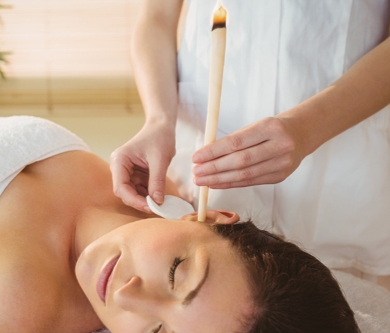How do ear candles work?
Ear candle treatment uses long, hollow ‘candles’ which are made of organic cotton and a selection of natural ingredients such as honey extracts, crushed herbs and beeswax.
The candle is gently placed about a quarter-inch into the ear and lit, allowing the flame to pass down the candle’s hollow centre. The warm air comes into contact with colder air, creating a vacuum effect. This is believed to draw out wax and other debris that may be lodged in the ear canal.
The removal of excess wax and impurities helps to clear the inner ear and sinuses, regulates ear pressure and brings about a lighter sensation in the head and ears. Ear candling also encourages deep relaxation, which is enhanced by the infusion of herbs and essential oils.
An ancient practice
It is thought that the Ancient Greeks were among the first to use the technique. They referred to it as ‘coning’ and used it specifically for cleansing, healing and purifying on a spiritual basis.
Gradually more ancient cultures picked up on the practice, including the Egyptians, Mayan and Inca tribes. The modern incarnation of ear candling is based on the technique envisaged by the Native American Indian tribe, the Hopis (meaning ‘peaceful people’).
The Hopis used ear candling in rituals and healing ceremonies and developed a specific candle formula to enhance the treatment’s holistic and therapeutic benefits. The main ingredients they used in their candles included cotton, beeswax, honey, sage, chamomile and St John’s Wort – a formula still used in modern ear candle treatments today.
Different types of ear candle
There are several different types of ear candles used in treatment today – each varying in size, shape and content.
The Hopi ear candle – These are made of the traditional Hopi formula and are around 22cm long. Burning time is about 10-12 minutes, and safety features include a filter (preventing particles from dropping into the ear) and a maximum burn line showing when the candle should be put out.
Ear cones – Unlike the traditional Hopi candles, these are wider at the top and much shorter in design. They are made from cotton, beeswax and propolis (aromatic substance collected by bees) and will burn for around 5-7 minutes. Safety features include a flame-breaking ring and a valve, which prevents particles from dropping into the ear.
Basic ear candles – Also referred to as ‘natural ear candles’, these are made only from cotton flax or hemp and beeswax. Sizes and shapes vary and specialised safety features are rarely included.
What happens during a session?
When carried out professionally, an ear candling session can be a relaxing and enjoyable experience for the client. At the start of the session, you will have a consultation, where your therapist will discuss your medical history and current symptoms to help assess if ear candling is the right treatment for you.
You will then be placed in a comfortable position on your side before the therapist gently places a specialised candle in your ear. This will be lit and held in place while it burns for around 10 minutes.
You are likely to hear a crackling sound as the candle burns and feel a warm, gentle massaging sensation in the ear. When the candle has burned completely, it will be removed from your ear and extinguished. This process is then repeated on the other ear.
Once both ears have been treated, your therapist will massage the area around the ears and face to encourage lymphatic drainage and enhance the effects of the candling. Many report an immediate relief of pressure after the treatment.
A session will last for approximately one hour. Some people may experience relief immediately after the first session but more may be needed depending on the nature of your ailment.
What do people use ear candling for?
Ear candling is a holistic and complementary treatment – it is therefore not designed to treat/cure any particular ailment. It is a natural approach and many people say they find it helpful for maintaining general health and well-being.
Those who may benefit from ear candling include those struggling with:
- migraines
- hay fever
- anxiety and stress
- post flying and driving pressure
- swimmer’s ear
- asthma
- vertigo
- yeast infections
- colds and flu
- parasites
- itching in the ears
Ensure you speak to your doctor about your symptoms to see if medical assistance is required. Ear candling works well as a complementary treatment, alongside medical interventions.
Is ear candling safe?
While it is considered a natural approach with no side-effects, ear candling does carry risks. Having a lit candle inserted into the ear requires expert handling and supervision to avoid potential problems such as a punctured eardrum or burns to the face, hair, scalp or ear.
It is also advised that the treatment is not carried out too soon after any form of ear surgery and if you have any of the following:
- cysts in the ears
- high blood pressure
- ongoing ear or sinus infections
- cochlear implants
- allergies to any products in the candle
- inflammation in the ears
- perforated eardrums
- grommets or tubes in the ears
- acute otosclerosis (an abnormal bone growth in the middle ear)
- mastoiditis (an infection of the mastoid bone behind the ear)
- difficulty breathing around small amounts of smoke
Generally, ear candling is a safe and relaxing experience – as long as the treatment is not used excessively or carried out incorrectly. This is why it is important to seek out a qualified practitioner who is able to carry out ear candle treatment professionally.


Recent Comments